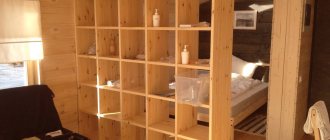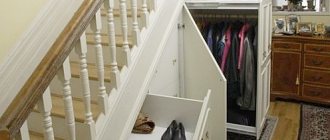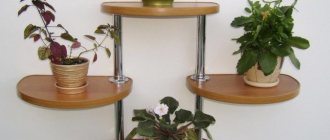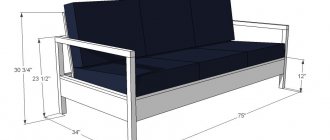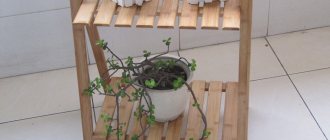Many owners think about how to equip a garage as a workshop. After all, it is quite convenient and practical. And most importantly, it’s useful, here you can not only do repairs, but also engage in individual activities and this can be a good income. Today we will tell you how to equip a garage with your own hands and at the same time take into account all the details. It is quite possible to do the interior arrangement yourself, in which case you will simply avoid additional costs.
Arranging the inside of a garage is not a complicated process, but here you just need to provide for everything. Everything for arranging a garage can be purchased at retail chains; however, some details and features will need to be taken into account. Before making a decision, you should watch the video and calculate everything. The height of the ceilings and the size of the garage will be important here. Arranging a 6x4 garage will be a standard solution. But there are quite different sizes and you will need to choose according to your measurements.
Choosing a location for a workshop
The arrangement of garages with a workshop begins with the correct determination of the location. Here you can place a workshop in the basement, or you can arrange it in the main part. It all depends on what you want to install. When choosing a place to create a workshop, first of all, you need to calculate how much space will be required for work, as well as what equipment, tools, and equipment will need to be placed in it.
These can be racks, machines, workbenches, etc.:
- It is necessary to imagine how much area will need to be allocated for this and multiply the planned value by a coefficient that can vary from one and a half to two. This is necessary in order to take into account the free space for possible gaps, work behavior and tool movement.
- Also, when planning, it is necessary to consider where tools and materials will be stored. If storage will be carried out directly in the workshop, then additional space for this must also be taken into account.
- If the work area is organized in an unheated garage, it is necessary to take measures to heat it. The easiest way to create heat in a room is to use electric heaters, which include a convector, fan heater or oil radiator.
- But it is necessary to take into account the fact that such devices consume a significant amount of electricity, and cannot create a constant microclimate. The best option is to insulate the workshop. Dryness in this room is very important for work, for the safety of materials and tools, and for the proper functioning of electrical wiring, which is negatively affected by dampness.
- Work in the workshop is impossible without good lighting in it. Work areas require the greatest amount of light, as sources of which it is better to choose a diffused option that does not create sharp shadows and does not create a distorted perception of proportions and sizes.
- It is also better to foresee in advance how much power the devices located in the workshop will consume, so as not to overload the wiring in this room. To reduce the noise generated during operation, it is necessary to soundproof the room.
- To avoid dust in the workshop, it is necessary to place a high-power vacuum cleaner in it, preferably one designed specifically for repairs. Such devices, as a rule, can not only suck in, but also blow out air, and are also provided with some additional elements, for example, sockets. It is best to remove dust from various surfaces using a rag, the place for which must also be provided in advance.
- It is also best to have a metal bucket in the visible area, which will be needed for various waste that may appear during work, for example, glass fragments, bent nails, parts, and more.
Rules for setting up a workshop
Garage workshop arrangement is done according to the basic rules that should be followed when arranging a workshop:
- It is necessary to plan twice as much space as is needed for all tools, equipment and machines. This is required for freedom of movement.
- For the stability of operating equipment, the floor(see) in the workroom must be level, hard and dry.
- Sound insulation and adequate ventilation must be provided.
Workshop safety
The garage must also be equipped from a safety point of view. It is very important to monitor the waste thrown into the trash can, and also not to store varnishes, solvents, paints and containers for them open for a long time, since the evaporation of these chemicals can cause illness. It is better to wear a respirator when working with chemicals.
Attention: Open flame sources must not be placed in the work area. It is very important to have a working fire extinguisher in the workshop, as there is a high probability of sparks during work, which can lead to a fire. Along with a fire extinguisher, you can use a blanket specifically designed for extinguishing fire.
There’s no way to have a workshop without a workbench.
Setting up a garage without a workbench is almost impossible. It can be called the essential equipment in a home workshop. He can be a carpenter for working on wood or a metalworker for metal. If you need to work with these two materials, you will most likely need both tables.
So:
- It is worth considering that a carpentry workbench is larger in size than a metalworker's workbench. So, the first option can have a length reaching up to 2.5 m, and the second only up to 1.5 m. The width of these tables does not differ much and can range from 0.5 to one meter.
- The price of a carpentry workbench is usually much higher than that of a metalworker, so some people prefer to assemble it themselves. In this case, it is necessary to ensure good stability of such a table, as well as massiveness of more than 1 quintal.
Attention: The height of the table must be selected according to the height of the master working at it. If this indicator is insufficient, it is better to create a foundation that allows you to raise the workbench. Otherwise, if it is necessary to constantly bend down while working, the master will get tired faster, and may even get quite severely injured.
- The surface of the table must have a vertical cavity in which the tool is placed when working with the material. It is better to place the workbench near a window, which is a good source of daylight. But at the same time, it is important to take care of safety and equip the window with a protective screen, as well as a chain-link mesh, which should be located in such a way as not to interfere with opening the window for ventilation.
- Artificial lighting for a workbench can be organized using a table lamp with a flexible base, which is secured with special clamps to the edge of the table.
- When working, you must have the necessary tools within reach, which can be located on shelves next to the table. Tools that are not needed very often can be put away in drawers, which can also accommodate small materials such as self-tapping screws, screws, nuts, etc. The workbench is usually complemented by a massive stool.
Equipping a garage with your own hands is done based on a number of requirements. There are several main ones:
- The workbench must be massive and also extremely stable. For the latter, it can be additionally fixed to the floor covering.
- The height of the tabletop should be comfortable for the craftsman; this will also additionally protect his work.
- The thickness of the table cover must exceed 40 mm.
- A vice is an important component of a workbench. They can have different sizes.
Tools
You need to do it yourself inside, taking into account the necessary tools, which can be either manual or in the form of equipment.
So:
- When choosing machines, it is necessary to take into account the ability of some of them to perform the functionality of some hand-held instruments. This will make it possible not to clutter the room with unnecessary devices.
- It is also important to choose those models that operate from a standard outlet providing a voltage of 220 V.
Arranging a garage with your own hands is not so difficult, it is important to provide for everything. Lighting will be an important point here. You should immediately decide on energy saving. Also, when doing wiring, do not use twists; purchase terminal blocks that will make the connection safe and reliable. The most important thing is to take your time and think everything through.
The farm has accumulated a lot of tools - manual and electric - and various small things: fasteners, scraps of steel, aluminum and wooden blanks...
I was going to place all this belongings in the garage so that, if necessary, I could quickly find what I needed without having to go through all the bins again.
The main questions I needed to solve were the following.
Storage of tools, materials, fasteners, a small amount of lubricant, paint, etc. Placement of stationary machines (for me these are drilling, lathe and sharpening machines) with the ability to work on them at any time.
I placed frequently used tools (drill, jigsaw, screwdriver, milling cutter, small grinder, etc.) on shelves or in packing cases. Tools for special purposes or those that require special conditions for use (chain and circular saws, electric planer, grinder for working with large discs, electric shears for metal, etc. - these tools will not be used in the room where the machine is located) are stored at me in the drawers of the bedside tables, which are easily pulled out on special runners with wheels.
In the same bedside tables, in special drawers with different-sized sections (honeycombs), I store hand tools and various devices. I place fasteners and hardware in special cassettes with small sections. Various jars and jars are used to store large quantities of hardware.
I placed the welder on a small metal table on wheels that fits conveniently at the bottom of a shelving unit in the back of the garage. Since I usually carry out welding work outside, I have to move the welding machine around the garage or outside it. It has become quite easy to do this.
There I also store a tool hopper (container) on wheels, which are equipped with locking devices. If you roll your car out of the garage, place this container in the middle of the room and block the wheels, you can use it as a workbench. Using clamps, you can attach a circular saw or plane to it and process long products made of wood, metal, plastic, etc.
To store frequently used tools (screwdrivers, wrenches, special keys for machine tools, cutters, cutting discs and much more), I made special tablets from laminated chipboard, which I placed on the walls of the garage.
I store drills from 1 to 10 mm (in increments of 0.1 mm) in a special jig with a marking of the drill diameter. The size of the hole in the jig matches the diameter of the drill. The jig can be used to calibrate drills (if the markings are not visible).
I made racks for storing things and materials almost along the entire perimeter of the garage at a height of 2 m. There's a lot of stuff in there; jacks, a pump, cans of paint and solvents, utensils for mixing mortars and many, many other necessary, not entirely necessary and completely useless items.
If your garage has a basement, like mine, then you can store a lot of things there too. But we must remember about the high humidity in the basement. Therefore, even with good ventilation, I do not recommend storing clothes, cardboard, etc. in the basement, which can become moldy or absorb the smell of dampness.
For work outside the garage, I collect the necessary tools and fasteners in a plastic box container. Having finished the work, I hang and put everything in its place in the workshop.
Lighting and heating of a workshop in a garage
The garage is brick, but not heated. To warm the room for work in cold or winter, just turn on a 1500 W electric heater. For lighting, I hung three spotlights with 500 W halogen lamps from the ceiling. In not very cold weather, the heat generated by these lamps is enough to heat the room. Local lighting of the workplace when working on machines is carried out with lamps with incandescent lamps, the design of which allows you to change the direction of light and the distance to the object.
ADVICE:
To make it easier to find the fasteners, I pasted labels with the contents written on them. For this purpose, pieces of ordinary medical plaster or multi-colored bright stickers for price tags used in stores are suitable. The color can indicate the type of fastener, and on the label itself I write its size - diameter and length and, for example, the type of head.
Making a folding bed yourself
To build a bed with your own hands, you will need boards, chipboard or fiberboard, plywood, fasteners, a lifting mechanism, hinges, a mattress, and belts. First of all, it is worth drawing up a project for the sleeping area, in which all dimensions will be accurately indicated. The best option would be a transformable bed that folds into a closet. In this case, its width and length should be slightly less than the width and height of the cabinet. Then we proceed to making the frame of the future bed from boards and chipboard. Please note that the structure must be, on the one hand, durable, and on the other, light. The front legs of the bed can be made in the form of a solid wall, mounted on hinges.
Particular attention should be paid to the installation of the lifting mechanism. As noted above, it is best to use gas elevators as a lift, the power of which is selected in accordance with the weight of the bed. The gas elevator is installed in this way: the parts are attached to the sides of the bed and the sides of the closet. The next step is to install the shock absorbers first from below and then from above. If you decide to make a single bed with a light bed, you can limit yourself to hinges and not install an additional lifting mechanism. After constructing and installing the bed frame and installing the lifting mechanism, all you have to do is lay the mattress and secure it with special straps. The final step will be the installation of cabinet doors and adjustment of fittings. Your trundle bed is ready for use.
In small apartments where a large number of people live, there is a need to save space. The issue of furniture placement can become acute in a children's room, especially if there is only one, and several school- or preschool-age children are forced to sleep in it. To significantly save space, you can buy a folding bed. You can create a drawing and make a wardrobe bed with your own hands. This will significantly save financial expenses and allow you to create a bed of the required dimensions, taking into account the color scheme of the room and the decorative elements present in it.
Before starting the bed manufacturing process, you must have a drawing, following which you can make a wardrobe bed with or without additional shelves. A detailed diagram of the arrangement of parts will help you create a high-quality bed as quickly as possible that will function correctly.
Such schemes most often involve the production of beds with dimensions of 1800*2000, 2120*1715, 2040*2200, 1731*2020. This is how double beds are made. Single beds are most often intended for children's rooms, therefore they are smaller in size. Since they are installed independently, it is possible to create a drawing of the size of the bed depending on the availability of free space, the age of the child and the possible use of this bed by younger children after older children grow up. To create a transformable bed, the drawings must be as accurate and clear as possible.
To make a wardrobe bed with your own hands, you will need the following tools:
- Drill;
- Screwdriver;
- Jigsaw;
- Saw;
- File;
- Pliers;
- Roulette;
- Level;
- Screwdriver;
- Carpenter's pencil;
- Sandpaper with different abrasiveness numbers;
- Furniture screws;
- Self-tapping screws.
This is a minimum set of tools; others may be required during the work process.
Tools
You also need to have the following materials:
- Furniture boards or chipboards;
- Wooden beams;
- Wooden boards;
- Loops for fastening;
- Corners;
- Hinge mechanism;
- Decoration materials;
- Materials for making legs.
This is also a minimum set of materials. Cutting is carried out according to the drawing. This is done like this:
- Using a tape measure and a pencil, all the details of the future cabinet are made in the form of patterns according to the data from the drawing;
- For patterns, you can use joined sheets of whatman paper or wallpaper;
- Each element must be signed;
- Mark the connection points and fastening points of the transformation mechanism.
Materials
Ventilation of a workshop in a garage
The garage must have good ventilation. Especially if welding, soldering and cutting of metal will be carried out there, and ventilation will not hurt when working with wood. I have two independent ventilation circuits in my garage - in the basement and in the room itself. Plastic pipes through which air circulates go to the roof of the garage. If you plan to work with paints, varnishes, impregnations, etc. in the workshop, then you need to make a forced exhaust using an electric fan.
Schematic drawing with dimensions
Before you begin work on making a cabinet, you should determine the height of the shelves and their number, and also determine the exact depth of the structure.
The standard size of a garage cabinet corresponds to the following dimensions:
When planning the manufacture of a cabinet, you need to consider the following points:
Thanks to the drawing, it will be possible to determine the material consumption and more accurately prepare all the parts.
Location and equipment of the work area in the workshop
The dimensions of my garage are 6.5 x 3.0 m2. If you place the machine close to the gate, then with a machine length of about 5 m, approximately 1.5 m remains in the rear. In this place I located the so-called working area. There I made a workbench rack that spanned the entire width of the garage. On it I installed a drilling machine, a vice and concentrated bedside tables with drawers for storing tools, fasteners and auxiliary equipment. I made the floor in this part of the garage from a floorboard; it is comfortable to work on even in winter. There you can do some work without driving the car out the gate.
In order for the car to be placed as close as possible to the garage door, it is necessary that the door in the gate wings be located as close as possible to the wall so that it is possible to enter and exit the garage without moving the car. Another little tip: the switch to turn off the electricity in the garage should be located next to the door. This will allow you to turn off the electricity just before closing the garage, so as not to leave it in the dark.
Basement equipment in the garage
Under the main room of my garage there was a basement bunker 2 m high. I divided it into two zones - food and technical.
He built a brick wall between them. The grocery room is located under the “working room” and is insulated from above (a layer of mineral insulation is laid between the floor slabs and the wooden floor). There you can store cans of preserves, potatoes, apples, etc. The technical area is located under the place where the machine is parked and has access to the main room along its entire length, about a meter wide. This part of the basement is convenient for car repairs, and I also store building materials that are not afraid of moisture there.
The basement is illuminated by 36 volt electric bulbs. For this, a transformer is used, which is located in the main room of the garage next to the electrical panel.
Garage cleaning
Don't forget about cleaning the room. To make this job easier, I use a vacuum cleaner that is located on the top shelf above the workbench. The flexible hose of the vacuum cleaner easily reaches anywhere on the workbench and is always at hand. It is better to immediately collect sawdust and shavings with a vacuum cleaner. For final cleaning of the workplace, you need: a long-handled brush, a dustpan and a waste container.
The vacuum cleaner was placed on the top shelf of the rack above the workbench. Turning it on and off using a standard switch is not always convenient. For this, there is a special socket with a switch, which is located in a convenient place at a low height.
In my garage I always have soap, hand washing paste, a fresh towel and a washbasin, which can be replaced by a plastic bottle with a stopper in which several holes are drilled.
In the workshop you need to have a first aid kit with a minimum set of medications (you can use a car first aid kit for this), a fire extinguisher and a piece of fiberglass in case of an unexpected fire.
In the garage basement the temperature does not drop below 0 degrees. So I planned to place a small water tank, an electric heater and a sink with faucet there.
Electricity in the garage
The garage needed some major wiring changes. There were several reasons for this. First, I use the garage as a workshop, and my welder, lathe and drill press run on three-phase power. Secondly, to illuminate the basement, for safety reasons, a low-voltage network is required, galvanically isolated from the general electrical network through a transformer. And besides, the various hand-held power tools that I use have plugs of a wide variety of designs for connecting to the mains. Powering them through adapters is not only unreliable, but also unsafe.
Power calculation and cable selection for a garage workshop
I began the implementation of my ideas by working out the general diagram of the electrical network of the garage-workshop (Fig. 7) and assessing the main current loads. When working alternately, machine tools and power tools consume a maximum of 2 kW, a welding machine (3 phases) - 5 kW.
I decided to use cables with only copper wires. Aluminum ones break after several kinks and, with the same cross-section, withstand 25-40% less current than copper ones.
If there is no marking on the wire, its cross-section can be calculated using the formula S = ND2/A, where S is the cross-section of the wire in mm 2;
N is a number equal to 3.1 A;
D is the measured diameter of the wire in mm.
The diameter of the conductor (without insulation) is measured with a micrometer or caliper. The cross-section of a flexible stranded wire is determined by the sum of the cross-sections of all wires included in the core. The conductors of the wires have standard cross-sections: 0.75; 1.0; 1.5; 2.5; 3.0; BP 6.0; 10.0 mm2.
If there are several simultaneously loaded conductors in one cable, then reduction factors are used. When calculating, the maximum permissible current passing through such a conductor must be reduced by approximately UP to %.
After calculating the current load, I entered the garage with a cable with four copper conductors with a cross-section of 4 mm 2, protected by a 25 A automatic machine. The three-phase sockets were connected to a cable with four conductors with a cross-section of U mm 2 (it was possible to take 3 mm 2), the automatic was used at 16 A. The socket blocks on the walls (maximum current - 10 or 1 bA) were powered by a cable in two 2.5 mm 2 cores. I connected the socket blocks on opposite walls of the garage to different phases. The lighting was carried out with a cable in two conductors with a cross-section of 2.5 mm2 and protected by a 10 A automatic circuit breaker. The three-phase meter on the panel is rated at 20 A.
Do-it-yourself electrical panel in the workshop
I developed the electrical panel diagram (Fig. 2) based on my own needs (Fig. 3). The phase wires from the general network were connected to the P1 circuit breaker (25 A), which has a combined splitter: electromagnetic - for instant shutdown in case of a short circuit and thermal - for shutdown in case of overload. This way I can remove the voltage to work in the panel itself or replace the meter without turning off all the tools.
The meter in the garage is in difficult conditions. High humidity and temperature changes in winter can lead to its failure. Being energized, it dries itself. In case of frost, some experts recommend installing a low-power light bulb next to the electric meter in an unheated room.
The neutral wire comes to block K1 and is routed from it to all devices using separate conductors. The installation of protective devices in the neutral wire in the presence of electrical appliances that require grounding is unacceptable. Moreover, all housings of machines, lamps, air heaters and grounding connectors of sockets with three plugs must be connected to a special protective conductor (PE or PEN).
If you have an individual grounding loop, which I strongly recommend, the protective wires from the housings of electrical installations do not need to be connected to the zero bus, but rather assembled on a well-grounded separate bus in the electrical panel. The body of the metal box of the shield must be zeroed.
Circuit breaker P2 is installed to protect and disconnect sockets. I have four outlet blocks in my garage. I tried to install different types of sockets in each of them. When working with hand-held power tools, this allows you to do without unnecessary adapters and avoid many inconveniences.
There are five types of sockets installed on the electrical panel (see Fig. 3). Sockets RZ, RD, P5 are connected to different phases, and sockets P6, P7, P8 are connected in parallel and connected to one of the phases. The P2 socket is three-phase, I connect the welding machine to it. Socket P1 (this type is used to connect electric stoves) is single-phase, for a maximum current of up to 25 A.
A voltmeter with a switch after the meter allows you to control the voltage on each phase. Lamp L1 is an indicator of voltage in sockets on one of the phases to which bipolar sockets are connected.
The PZ automatic switch serves to protect and turn off lighting in the garage itself, in the basement and turn on the forced ventilation engine. Formally, the lighting is divided into zones at the front and rear of the garage. Full illumination is not always needed here. Sometimes the emergency light of a lamp located near the entrance to the garage, or lamps in one of the zones, is quite enough. I illuminate my workspaces with additional lamps, which I connect to sockets.
Switches B1 and B2 supply voltage to the electromagnetic starters (P4, P5) for controlling the inclusion of light in the rear and front zones of the garage, and switch VZ - to the 220/36 V transformer for lighting the basement (Pb). To prevent moisture from getting into the lamp sockets, I used lamps of a sealed design in the basement, and placed the wires in plastic corrugated pipes.
There are two buttons VD and B5 on the side wall of the shield. They control the P7 electromagnetic starter, which supplies voltage to the forced ventilation motor. Light L2 is an indicator of ventilation operation.
I plug the lathe into a three-phase outlet. Floodlights and lamps for lighting the garage are connected to the network through installation boxes installed on the walls.
When thinking about how to arrange the inside of a garage, we usually want to combine incompatible things:
- Get a comfortable workplace;
- Provide opportunities for get-togethers with friends;
- Make your garage stylish and cozy;
- Avoid big expenses.
And if you think that this is unrealistic, then after reading our article you will understand that you were mistaken.
Take a look at examples of apartment design in the fashionable loft style. By the way, they look more like garages than living quarters. Rough brickwork, visible beams, strange accessories... All this can look very good. Here you can see a lot of garage ideas. The loft allows you to turn the disadvantages of the premises into advantages, reception at a very affordable price. There is a lot to learn.
In such an interior, things made by hand look more than natural. Even if the item you made looks a little rough, don’t be upset, maybe it’s even for the better!
How to arrange a garage inside
How to arrange a garage inside? Show your imagination or use other people's ideas. Surely you have a lot of scraps of pipes and boards, several empty plastic cans and other rubbish that you would hate to throw away. Use it. And space will be freed up, and you will be able to save money.
Of course, there are things you shouldn't skimp on. For example, it is better to use a specialized one. When solving the problem, you should also avoid various homemade products.
How to arrange the inside of a garage - do-it-yourself folding workbench
A work area or workbench for a garage, especially one designed for professional use, is a very expensive pleasure. But you can just do it yourself. No complex equipment is required for this. The main thing is to adhere to the dimensions recommended from an ergonomic point of view. You can take your favorite industrially produced model as a basis.
How to arrange a garage inside - you can make a convenient stand for storing tools with your own hands
It’s also easy to make a convenient stand for tools with your own hands. You just need to take a sheet of plywood and drill a hundred neat holes in it. And if you hang several sheets on hinges in the form of a book, the owners of neighboring garages will simply be jealous.
The final stage is decoration
The facade of the final product is often decorated with false doors - an overhead element that is part of the decoration, onto which handles are attached. Do not use mirrors in such beds under any circumstances, as they are not designed for such loads and may soon crack.
Even the simplest folding bed design can fit into any room interior.
This will also affect the weight of the structure being lifted, which may affect the durability of the mechanism. Be sure to install the legs into the pre-drilled holes and magnetic latches. Now the work is completed, and the new decoration of your interior is completely ready for your relaxation.
A single folding bed can be installed in the front room, and no one outside will even think about its presence, since it will be disguised as a closet.
Cosiness
What makes a garage feel cozy is not practical things, but excesses. In addition to, hang a stylish homemade lamp, place a coffee table made from an old tire... You won’t have to spend much, and at the same time add old trash that is collecting dust on the shelves.
A properly equipped workshop in the garage (very often a workplace for “dusty work” is equipped in the basement) can become a comfortable and functional workplace for a car enthusiast who prefers to service the car on his own, or simply do something with his own hands. Before you understand the process of setting up a workshop in a garage, you need to understand the basic principles and rules of this process. In fact, they will be discussed today.
It is not without reason that it is generally accepted that the garage is the second home of the car owner. A workshop located in a garage has many advantages. This building serves not only to shelter the beloved “iron horse” from bad weather, but also to store various tools and equipment necessary for repair work.
Interesting to know! Very often, non-car items are stored in the garage, for example, bicycles, old clothes and even vegetables. This greatly expands the usefulness of the garage for a family.
Each owner tries to approach the issue of arranging a garage from the point of view of his personal preferences. It is important to note that a workshop equipped in a garage must meet certain requirements. Otherwise, instead of benefit, the garage will bring only problems. How to do it? To do this, you can use simple tips from our research.
Important! The specifics of the arrangement depend on how the workshop located in the garage will be used. If we are talking about making money by repairing cars, you will need to take care of installing special professional equipment.
The room where the auto repair shop will be located must be dry and warm. In addition, it is important to protect it well from third-party penetration. You can install a high-quality lock, or you can equip your garage with an alarm system. No matter what you equip, the protection should be at a high level. It all depends on the financial capabilities of the owner. Before setting up a workshop, you need to think about the location of equipment and tools, to which free and convenient access should be provided. In addition, all material assets must have their place. These are just general recommendations that will help equip your workshop. To carry out various types of work you will need more specific equipment.
Folding bed options
- Folding. A very convenient option that allows you to significantly save room space, since the structure can be completely removed. You can make such a bed yourself; just take a regular spring mattress, place it in a wooden frame and fasten the structure with loops to a beam nailed to the wall.
- Secretary bed. This design consists of two supporting posts to which a folding bed is attached. In this case, the outer wall, when folded, will serve as a desk cover.
- Folding bed. A well-known Soviet-era version. Modern folding beds are more convenient and compact, they fold easily and can be stored in special bedside tables and cabinets.
Installing racks and shelves
Often, high-quality arrangement of a workshop requires a lot of space, which is not always physically possible. After all, a huge number of tools and household appliances need to be stored somewhere, not forgetting that you need to leave room for the vehicle itself. Therefore, it is necessary to provide as much space as possible for shelves, racks and all kinds of cabinets. They should be located in such a way as not to interfere with free movement around the garage. They can be placed anywhere where they will not interfere.
Important! When hanging shelves, the distance from the car should be at least one meter.
A very convenient place in the garage for this is the wall farthest from the gate. As a rule, it is equipped with different shelves and racks. It’s better to put what you plan to use more often at eye level or slightly below so that it is at hand. It is better to place heavy equipment at the very bottom (if the rack covers the entire wall). On the uppermost tiers you can store various boxes and other small items that are not used often. It’s a good idea to build a small locker for clothes, because, as a rule, people always work in the garage in work clothes.
Preparatory work for the manufacture of cabinets
Before starting the manufacture of any product, it is necessary to develop a project.
Tip: The ideal solution is to completely or almost completely free one of the walls of the garage and leave it to accommodate cabinets.
Tip: It is not advisable to make deeper shelves. It will be very inconvenient to retrieve objects from great depths. To store fasteners and hand tools, cabinets can be shallower, up to 40 centimeters deep.
Setting up a “pit”
The issue of building a “pit” is very individual, but for minimal maintenance of the machine it is simply necessary. If you decide to do it, you can use several recommendations:
- It is best to make the walls and floor concrete.
- The edges of the “pit” need to be strengthened with iron corners.
- It is imperative to think about how to cover the “pit” when it is not in use. As an option, use a base made of strong boards fastened together.
- In the walls of the “pit” you can provide special niches for tools.
- It is important to think through the “pit” lighting system in advance;
The importance of arranging a “pit” is that it can be used to diagnose faults in the vehicle’s chassis, as well as replace some of its parts and change the oil. Having a “pit” and shelving in the garage, we can already talk about partial arrangement of the workshop.
What you need to create a closet
To make a cabinet with your own hands, prepare the material itself (plastic, chipboard, metal sheets, wooden boards), metal pipes, corners. To make the furniture high-quality and durable, you need to stock up on tools.
Basic material and additional equipment
To make furniture you need to choose durable, safe material:
For garage furniture, it is better to use a material that is fire-resistant, impact-resistant, does not absorb moisture, does not fade in light, and is easy to clean with modern cleaning products.
Tools
To make your own garage cabinet, you will need the following tools:
If you have these tools, making any furniture for the garage will not be difficult and will not take much time.
The most necessary equipment for an auto repair shop
If you just need to replace a wheel or “tweak” something under the hood, then it will be enough to have a jack and a standard set of tools.
But to perform more complex tasks, special equipment is needed:
- Crafting table. You can buy it at a specialty store, but you can also make it yourself. For this you will need wood and metal. The future working area needs to be covered with a piece of metal, which will protect the wood from premature wear.
- Welding machine. For repairs in a garage, a unit with tungsten electrodes in a protective gas environment is sufficient. A carbon dioxide machine that welds metal with wire is also suitable. It is important not to forget that if the garage has a wooden floor, welding work cannot be performed.
- Water-oil separator. Used to clean the air from vapors, oil droplets and other components that may be present in it. In addition, the device is used when painting a car.
- "Pneumatic impact wrench." A very convenient device that allows you to remove a wheel or unscrew bolts to dismantle various parts in a matter of minutes. Powered by network.
The modern market offers a lot of useful automotive equipment for almost any purpose and need. It all depends on what kind of repair work will be carried out.


